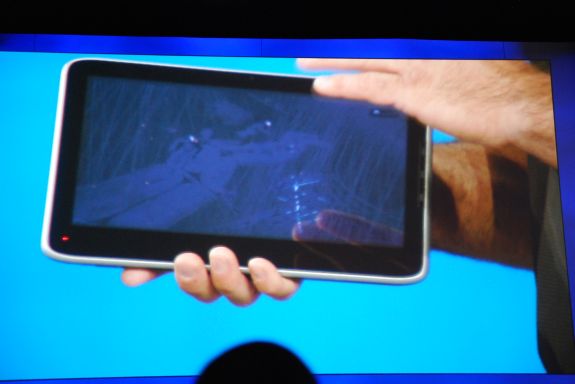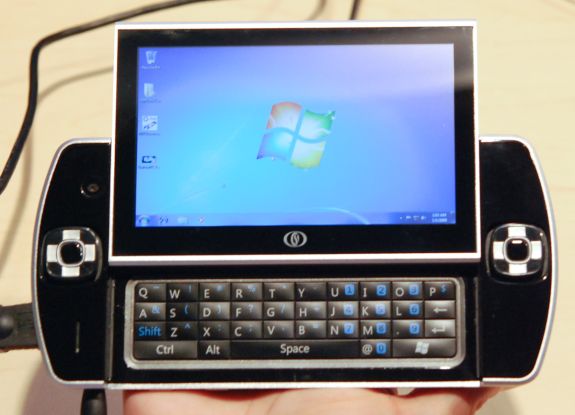First Public Demo of Oaktrail and Windows Gaming Tablet
by Anand Lal Shimpi on September 14, 2010 1:16 PM EST- Posted in
- Trade Shows
- Intel
- Atom
- Laptops
Earlier this year Intel unveiled its Moorestown architecture, branded as the Atom Z600 series for smartphones and handhelds. Moorestown focused on a significant reduction in idle and active power, the former enabled by completely ditching the PCI bus. While this well for getting Atom into smartphones, the missing PCI bus means that you can't use Moorestown in Windows.
Intel made an alternate version of Moorestown to address this shortcoming. Oak Trail takes the Lincroft SoC (CPU + GPU + memory controller) and pairs it with a new PCH, codenamed Whitney Point. Whitney Point adds PCI support, enabling Windows support.
Just a few minutes ago Intel demonstrated its first Oak Trail platforms, both shipping in 2011. The first was a conventional looking tablet:
But the second was the OCS1 handheld Windows gaming device running Oaktrail. Intel didn't tell us much about the system but it has a sliding keyboard and a pair of d-pads.












13 Comments
View All Comments
RU482 - Tuesday, September 14, 2010 - link
I would have thought Tunnel Creek to be a better recipient of the Z6xx nomeclature, being the sucessor to Menlow/Z5xxIntelUser2000 - Tuesday, September 14, 2010 - link
Well, the Menlow platform had UMPC/Tablet versions that were branded the same as the embedded versions(more or less).The TDP of the I/O hub on Oak Trail should be lower than the one on Tunnel Creek.
Shadowmaster625 - Tuesday, September 14, 2010 - link
All this intel atom crap is really giving windows a bad name. (As if microsoft needs intel's help with that!) Bobcat cant get here fast enough.jmv2009 - Tuesday, September 14, 2010 - link
Why does windows need a freaking pci bus?There was no PCI bus in the original PCs?
Windows NT and even windows 7 probably works on a 386 on an isa vga card without any pci devices in safe vga mode.
You probably just need a driver for the available video output.
IntelUser2000 - Tuesday, September 14, 2010 - link
Damn, I think Anand is confused. He should say "legacy" support. Things like ACPI and BIOS.DanNeely - Tuesday, September 14, 2010 - link
No. the PCI bus has been listed in many places as being the problem since Moorestown was released. The problem is that the PCI host controller is continually pooling for attached devices that want to talk to it and would kill the battery on a mobile phone as a result.I don't know the status of ACPI support.
Windows 7, and IIRC Vista, can boot from EFI instead of BIOS. XP can boot from a BIOS emulator running on top of EFI (this is how boot camp works). BIOS might not be a problem though, white it along with the FDD, PS2, and other legacy IO ports are all attached via the Low Pin Count bus (a 33mhz semi-serial bus that emulates ISA) Intel also uses the LPC to connect newer devices like the TPM encryption module. If the power draw is low enough (and I've no clue on what it is) It's possible that Intel has kept LPC available because the use of TPM would allow them to claim a MeGoo device could be locked down more tightly than a Blackberry.
cashkennedy - Wednesday, September 15, 2010 - link
I believe without the pci bus you wouldnt be able to connect traditional forms of storage ( sata connections) or even various network connection. Which would all be pretty necessary to get any use out of windows 7."But the Whitney Point additions now include SATA, HD Audio, HDMI, and a variety of legacy I/O." according to another site.
DanNeely - Tuesday, September 14, 2010 - link
Just because ancient versions had a feature doesn't mean that MS would continue to support a code branch for years after there's no longer any hardware that needs it.I've done some searching and have been unable to find evidence of XP running on anything older than a pentium class CPU on a 486 mobo that had PCI slots. Since the person who did that test underclocked the CPU all the way to 8mhz I assume he tried older hardware but was unable to do make it work.
I was able to find a video showing win2k running a on a 486 CPU but they never opened the case on camera and since the narration was in German I don't know anything else about the hardware. ie if the mobo had PCI or if it was ISA only.
I was unable to find anything on the minimum needed for NT4. Win98 can be installed on a 386, but that's a completely different kernel and not particularly relevant.
http://www.winhistory.de/more/386/xpmini_eng.htm
http://www.youtube.com/watch?v=Jxp34qsxJmY
http://www.winhistory.de/more/386/386vers.htm (in German but Google translate is good enough)
mino - Wednesday, September 15, 2010 - link
Remember that NT3 was a 1993 bird. All it needed was i386 with ISA.You may not know that, but the ISA bus is still present today as sub-component of the PCI spec.
From a software POW PCI is just an ISAv2 sort of.
Since PCIe is just PCI with a different wiring, MS never got a reason to ditch its core kernel stuff.
Anyway, they got the WinCE platform for this.
phil42 - Thursday, September 16, 2010 - link
will that osc1 thing run linux?